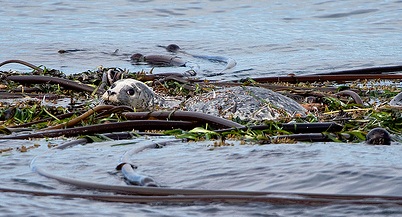Join a Kayak Quest for Whales Today!

We visit many different marine habitats on our kayak tours in the San Juan Islands. Perhaps the most impressive are the lush bull kelp forests that undulate rhythmically in the ocean currents. Bull kelp, or Nereocystis, can reach lengths of 200 feet and weigh 300 pounds. It is one of the fastest growing organisms in the world and can grow 8 inches per day during long spring days.
All kelps are algae, a classification more primitive than true plants and there are over 200 species in the San Juan Islands. Like plants, kelps photosynthesize sugars from the basic ingredients of carbon dioxide and sunshine. Together with the single-celled phytoplankton responsible for making our waters their trademark emerald color, kelps are “primary producers”. This means that they form the base of the marine food web in the San Juan Islands and generate all of the building blocks of nutrition (biomass) that are passed up through each link in the ecosystem ‑ all the way up to orcas, eagles, and kayakers. Both phytoplankton and kelp also contribute the majority of oxygen in our atmosphere while absorbing excess carbon dioxide ‑ they are essential to all life on planet Earth.
Unlike plants, which are more advanced, kelps lack a vascular system, flowers, and roots. They remain firmly attached to the rocks by “holdfasts”, special adaptations that grip the bottom. The stipe is the stem-like growth that allows kelp to reach for the sun. Bull kelp’s stipe is hollow, as is the floating bulb at the end. Both are filled with gas that lifts the kelp to the surface for maximum solar exposure. The narrow, translucent blades all attach to the float and wave in the current like the amber tresses of a mythical mermaid beckoning to kayakers.
Floating kelp canopies form huge vegetative rafts in the San Juan Islands of Washington state. These rafts are a great place to “park” your kayak out of the powerful currents. Kelp also absorbs wave energy to provide a restful place for enjoying the spectacular views of Washington’s mountains. Kayakers aren’t the only sea life that takes advantage of the kelp in this way. Sea otters and seals frequently wrap themselves in kelp while napping.

Kayakers in the San Juan Islands should look beneath the amber kelp canopy to spot a variety of animal life. Just like forests on land, bull kelp forests shelter animals from predators and harsh environmental conditions. Kelp crabs, snails, jellies, and much more can be spotted. Some species are specially adapted to live nowhere else. Besides being essential fish habitat, a primary producer, and shelter to wildlife and kayakers, bull kelp protects beaches from erosion by slowing wave and current action. Without kelp forests, the landscape as well as the marine ecosystem would dramatically change.
Amazingly, the extensive bull kelp forests of the San Juan Islands are destroyed by storms each winter and must grow anew every spring. An individual Nereocystis luetkeana releases a trillion spores into the water, most of which are lost to the depths, the desiccating beaches, or filter feeders such as clams and cucumbers. All it takes is one-in-a-trillion to replace itself the next year. But it must land on a current-swept rock protected from surf at a depth of 20 to 40 feet – incredible survival odds!
Native Americans in the Salish Sea used bull kelp for many purposes. Stipes were used as fishing line and braided into strong ropes. Bulbs were used to store water and fish oil. Gauntlets were carved into living bull kelp forests to herd migrating salmon into narrow passages where nets awaited. Euro-American colonists in the San Juan Islands used bull kelp as fertilizer and one early entrepreneur created a factory to export it. Modern Americans use several species of kelps for extracting algin, agar, and carrageenan that are used in products that range from ice cream to toothpaste to medical supplies. Fortunately, bull kelp is not commercially harvested today in the San Juan Islands. However, the industry relies heavily on other kelp species that may be getting over-exploited in other parts of the Pacific Northwest.
Nereocystis is edible for humans, like nearly all species of kelp, and can be enjoyed pickled, dried, steamed or raw. We encourage our kayak tour guests to sample fresh bull kelp as it is tasty and highly nutritious. You can sample a taste of the sea by joining Sea Quest for a San Juan Islands kayak tour.